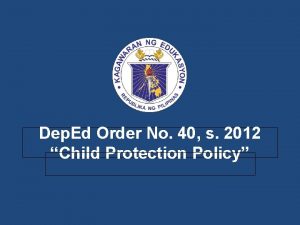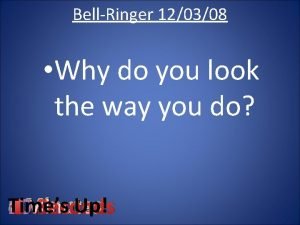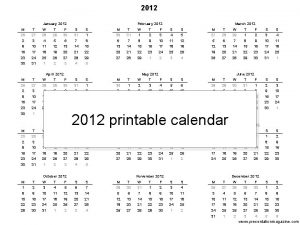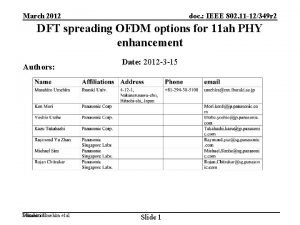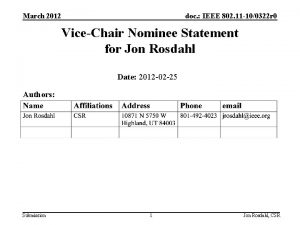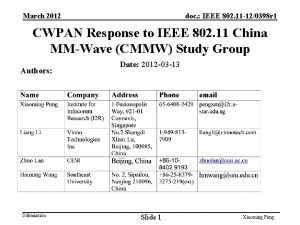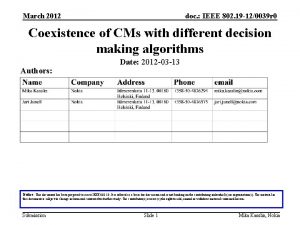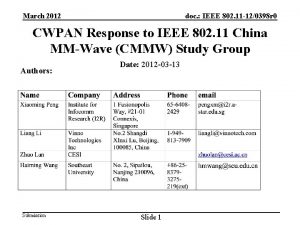March 2012 doc IEEE 802 11 120308 r









![March 2012 doc. : IEEE 802. 11 -12/0308 r 1 References [1] 11/1483 r March 2012 doc. : IEEE 802. 11 -12/0308 r 1 References [1] 11/1483 r](https://slidetodoc.com/presentation_image_h2/990dd2fc827c6dc45710b8c73d81c919/image-10.jpg)



- Slides: 13

March 2012 doc. : IEEE 802. 11 -12/0308 r 1 Revisit 2 MHz SIG Field Authors: Submission Date: 2012 -03 -12 Slide 1 Hongyuan Zhang, et. Al.

March 2012 doc. : IEEE 802. 11 -12/0308 r 1 Authors continued: Submission Slide 2 Hongyuan Zhang, et al

March 2012 doc. : IEEE 802. 11 -12/0308 r 1 Authors continued: Submission Slide 3 Hongyuan Zhang, et. Al.

March 2012 doc. : IEEE 802. 11 -12/0308 r 1 Abstract This presentation fixes a bug in the >=2 MHz SIG field in current TGah spec framework. Submission Slide 4 Hongyuan Zhang, et. Al.

March 2012 doc. : IEEE 802. 11 -12/0308 r 1 Background • In TGah, for 4/8/16 MHz BWs, the 2 MHz SIG is repeated in each 2 MHz sub-band – – • Receiver doesn’t know the BW (2/4/8/16 MHz) until decoding the SIG field – – • With some phase shift to reduce PAPR Similar to 11 ac. Same as in 11 ac, where the receiver may decode SIG field in the primary 2 MHz only Requires LTF 1 sequence to be the same, on the tones which the SIG field occupies, in each 2 MHz sub-band— refer to 11 n GF 40 MHz HTLTF and HTSIG designs. According to current 11 ah spec framework – – 2 MHz SIG field occupies 52+4 tones, in {-28: 28} of 2 MHz band—refer to [1]. LTF sequences of 2/4/8/16 MHz are the same as the 20/40/80/160 MHz VHTLTF sequences in 11 ac. Example: 4 MHz, SU format STF Submission LTF 1 QBPSK SIG LTF 2 Slide 5 … LTF_NLTF DATA Hongyuan Zhang, et. Al.

March 2012 doc. : IEEE 802. 11 -12/0308 r 1 Issues with Current 2 MHz SIG (1) • 4 MHz/8 MHz/16 MHz transmissions have 5 and 6 guard tones at edges—same as in LTF sequences. – • When a 2 MHz SIG sent on 56 non-zero tones, is repeated in 4 MHz/8 MHz, the SIG field for those BWs will be left with only 3 and 4 guard tones – • Occupied tones: 4 MHz: {-58: 58}; 8 MHz {-122: 122}. Occupies 2 extra guard tones at each edge, and there is no LTF sent in these extra tones! Same issue in MU packet “Omni-portion” Field Tone Mapping (2 MHz) Tone Mapping (4 MHz) LTF, DATA SIG -28 -1 1 28 B A -28 Submission -1 1 Slide 6 -58 A 28 -60 -2 B 2 A -4 4 58 B 60 Hongyuan Zhang, et. Al.

March 2012 doc. : IEEE 802. 11 -12/0308 r 1 Issues with Current 2 MHz SIG (1) • Reminder: In 11 ac, the 40/80 MHz the VHT-LTF sequences are not repetitions of the 20 MHz VHT-LTF – – • • No common 56 tones sequence exists in each 20 MHz sub-band The only thing that repeats itself in the 40/80 MHz, is a 52 tone sequence (26 tones each of LTF left and LTFright) Consequently, 11 ah LTF sequences in 4/8 MHz do NOT have 56 tones which repeat in each 20 MHz subband If the SIG is sent on 56 tones in each 2 MHz sub-band, receiver cannot demodulate SIG field as it does not know the LTF sequence LSIG/VHTSIGA Tones 11 ac 20 MHz: LSIG/VHTSIGA Tones 11 ac 40 MHz: LSIG/VHTSIGA Tones 11 ac 80 MHz: LSIG/VHTSIGA Tones Submission Slide 7 LSIG/VHTSIGA Tones Hongyuan Zhang, et. Al.

March 2012 doc. : IEEE 802. 11 -12/0308 r 1 Solution: Reduce 2 MHz SIG to 48+4 Tones • • The easiest solution is to send the 2 MHz SIG field within tones {-26: 26} as in 11 n/11 ac. SIG field modulation flow becomes the same as 11 n/11 ac HTSIG/VHTSIGA – • 48 tone interleaver, instead of 52 tones SIG field reduces to 48 bits—reduce number of PAID field to 9 bits, which is the same as 11 ac PAID Length / Duration MCS BW Aggregation STBC Coding SGI GID Nsts PAID Reserved CRC Tail Total Submission SU MU 9 4 2 1 1 2 1 9 2 1 5 1 6 8 2 12 9 8 7 4 6 10 6 4 6 52 48 Slide 8 Hongyuan Zhang, et. Al.

March 2012 doc. : IEEE 802. 11 -12/0308 r 1 Side Note • Presentation 11/1483 r 2 [1] added into TGah spec framework the following sentence, which is incorrect and needs to be removed: – “LTF signs in the tones of each 2 MHz sub-band, when overlapping with the tones with a stand-alone 2 MHz LTF, have the same values as the corresponding signs in 2 MHz LTF. ” Submission Slide 9 Hongyuan Zhang, et. Al.
![March 2012 doc IEEE 802 11 120308 r 1 References 1 111483 r March 2012 doc. : IEEE 802. 11 -12/0308 r 1 References [1] 11/1483 r](https://slidetodoc.com/presentation_image_h2/990dd2fc827c6dc45710b8c73d81c919/image-10.jpg)
March 2012 doc. : IEEE 802. 11 -12/0308 r 1 References [1] 11/1483 r 2 “ 11 ah preamble for 2 MHz and beyond”. Submission Slide 10 Hongyuan Zhang, et. Al.

March 2012 doc. : IEEE 802. 11 -12/0308 r 1 Motion-1 • Move to make the following text change in section R. 3. 2. 1. 1. A of the spec framework? – “SIG Field • 2 symbols, each modulated using Q-BPSK, same as in 11 n green field preamble. • 52 48 data tones occupying tones {-26: 26} within each 2 MHz subband, and modulated using 11 n/11 ac MCS 0. – Note that 11 n HTSIG uses 48 data tones. . . ” Submission Slide 11 Hongyuan Zhang, et. Al.

March 2012 doc. : IEEE 802. 11 -12/0308 r 1 Motion-2 • Do you agree to make the following change in section R. 3. 2. 1. 1. E of the spec framework? Length / Duration MCS BW Aggregation STBC Coding SGI GID Nsts PAID Reserved CRC Tail Total SU MU 9 4 2 1 1 2 1 9 2 2 12 9 87 4 6 52 48 1 5 1 6 8 10 6 4 6 52 48 – …. – i. PAID: 12 9 bits PAID to accommodate more clients than 11 ac, not needed for MU. Submission Slide 12 Hongyuan Zhang, et. Al.

March 2012 doc. : IEEE 802. 11 -12/0308 r 1 Straw Poll-3 (Pre-Motion) • Do you agree to remove the following sub-bullet in R. 3. 2. 1. 1. D of the spec framework? – “ …. b. LTF signs in the tones of each 2 MHz subband, when overlapping with the tones with a stand-alone 2 MHz LTF, have the same values as the corresponding signs in 2 MHz LTF. …. ” Submission Slide 13 Hongyuan Zhang, et. Al.













